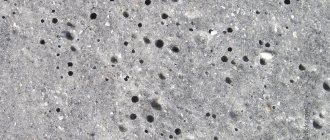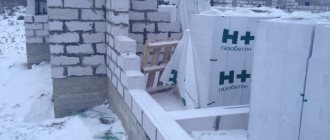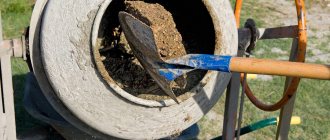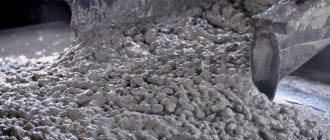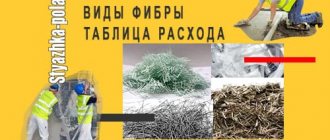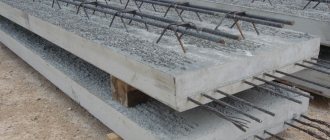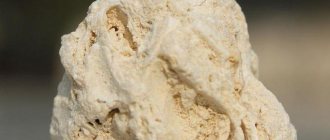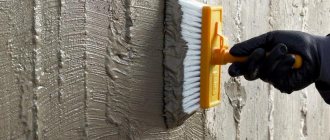Frost resistance of concrete is one of the most important characteristics for construction in latitudes where frequent and significant temperature changes are observed. More precisely, the frost resistance of concrete is the ability to go through several cycles of freezing and thawing without significant damage or deformation of the internal structure of the concrete structure. In this case, a threshold of loss of strength characteristics of up to 5% must be observed. That is, if concrete loses more than 5% of its strength after freezing and thawing, this is considered a violation of the technology.
To indicate frost resistance characteristics, the symbol “f” and a numerical designation from 50 to 1000 are used, which directly indicates the number of permissible freezing and thawing cycles without loss of strength characteristics. For example, frost resistance f50 is an indicator indicating that concrete can go through 50 freezing cycles without obvious loss of strength. There are also more resistant concretes with frost resistance f150, 200, 300, etc.
In this material, we will talk about such a property of concrete as frost resistance. We'll tell you how to determine the frost resistance of concrete. Let us dwell in detail on the classes of concrete taking into account this characteristic, as well as the methods available today to increase it. First things first.
What determines the level of frost resistance?
The main parameter influencing frost resistance properties is concrete porosity. The more voids in the intergranular space, the higher the likelihood of destruction of the material after freezing. The bottom line is that water, getting inside a concrete structure, transforms into a different state of aggregation (freezes), expanding by about 10-12%, which destroys the internal structure. At the same time, the frost resistance class of concrete decreases.
Another less obvious parameter that affects resistance to frequent temperature changes is water resistance (indicated by the symbol “W”). The higher this parameter, the less moisture gets inside the structure both at the drying stage and during subsequent operation. Accordingly, the less moisture, the lower the likelihood of concrete freezing and damaging the integrity of the internal structure. For example, concrete with frost resistance f50 has medium (fine) porosity and average water resistance. If the frost resistance of f300 is assessed, for example, then the porosity will be even lower and the water resistance higher.
Methods for determining (measuring) frost resistance
To determine the number of cycles that concrete can withstand, special tests have been developed that are consistent with the current state quality standard (GOST). The frost resistance of concrete is determined in laboratory conditions in normal or accelerated mode. Features of the conventional determination method:
- Especially for laboratory tests, a cube of concrete is cut out (size from 50 mm to 250 mm), which has dried at a certain temperature in accordance with technological regulations for at least 28 days.
- The concrete cube being tested is tested for strength using a special press.
- The sample is then frozen and thawed at temperatures from -18 °C to +18 °C until its strength decreases by more than 5%.
The maximum number of cycles recorded during the study will serve as the basis for marking the concrete. If the sample has withstood 75 or more cycles, then the frost resistance is f75, if it is more than 100, then it is f100, etc. This method is considered more reliable and reliable, but it also takes much more time. This testing method is used to determine the frost resistance class when developing new recipes for concrete production or monitoring the quality of products from an individual manufacturer.
Accelerated testing is carried out using special compounds, for example, an aqueous solution of sodium chloride NaCl (5%). The frost resistance class of concrete is determined according to the same principle, but the cycle of freezing and thawing is intentionally accelerated using various chemicals.
It is worth noting that cyclicity values obtained in laboratory conditions almost always differ from real values during concrete operation. Most often, concrete can withstand more cycles than indicated on the label. That is, if the frost resistance grade is f100, then the concrete structure will withstand 110 or more cycles.
How to determine the frost resistance class yourself? There are several factors by which you can roughly calculate the number of cycles provided by the manufacturer, but the results of these studies cannot be used in design documentation. What criteria are used to determine frost resistance f 50, f 100, etc.:
- Visually. Low resistance to temperature changes will affect the integrity of the concrete, which will visually look like small and medium cracks, delamination, peeling or brown spots.
- Increased water absorption. It is quite difficult to determine by eye the percentage of water absorption by concrete, but frost resistance f 100, for example, does not allow a water absorption rate higher than 5%. Simply put, the material should not absorb water.
- Deformation of the structure after drying in the sun. Another characteristic sign of a decrease in frost resistance is the formation of small and medium-sized cracks when drying in the sun. If concrete initially had f200 frost resistance, then after cracks appear, this characteristic can be reduced or even canceled.
Let us repeat once again that independent testing will not be reliable, and its results cannot be used in project documentation.
What does the brand of brick mean?
The main masonry building material for the construction of a wide variety of structures is brick. Today, this artificial stone is produced from various raw materials and is divided into several types based on raw materials. Within the type, brick is divided into varieties, according to the scope of application. Regardless of the type and purpose, all produced bricks are characterized by grades.
WHAT DOES THE BRICK BRAND MEAN?
This term denotes two concepts.
- Strength of brick to load and deformation (compression, tension, bending). Shows what load in kilograms per square centimeter of surface a brick will withstand without deteriorating characteristics or compromising its integrity. Marked as M kg/cm². There are 8 main strength grades from M-50 to M-300. Clinker bricks can also have a strength of M-500 and M-1000. Sometimes a mark is placed on a brick in the form of a number, which indicates the brand of the brick for strength.
- Frost resistance of bricks. Shows how many cycles of complete freezing and thawing the brick will withstand before it begins to collapse. Marked as F or Mrz. Brands are produced from F-15 to F-300.
STANDARDIZATION
Strength and frost resistance grades are regulated by GOSTs: a batch of bricks undergoes tests, based on the results of which a grade is assigned to it. Usually, 5 bricks are selected at random from a batch. To determine their strength, they are given maximum loads and tested for bending and compression.
To test the frost resistance, the brick is kept in water for 8 hours, frozen through, and then put back into water. How long it will withstand until the standard characteristics change is the frost resistance grade.
BRICK BRANDS
The brand of brick largely depends on the raw materials and production method. Indicators for different types of bricks are as follows:
APPLICATION OF BRICK ACCORDING TO BRAND INDICATORS
The optimal brick for private low-rise construction is M-100 or M-150 brick. Its strength is sufficient for the construction of load-bearing structures of up to 3 floors.
Concrete classes for frost resistance
There is such a thing as a frost resistance grade of concrete. And we are talking specifically about the grade of concrete, which in turn determines its class and partly its waterproof properties.
For example:
- frost resistance grade f50 is concrete grade M100-150 with strength classes B7.5, B10 and B12.5, respectively, and water resistance class W2;
- class f100 is determined by concrete grades M200-250, strength class B15-B20 and water resistance W4;
- grade M300-350 with strength B22.5-B25 and water resistance W6-W8 indicates that this is f200 concrete ;
- if grades M400-M600 with strength indicators from B30 to B45 and water resistance class W8, W10 or W18 are used, then the frost resistance class of concrete is f300 .
We hope that the material presented regarding frost resistance classes is not too difficult to understand from a technical point of view. And if someone asks you: “Frost resistance f50 - what is it,” you can explain the methods for determining the class of concrete resistance to temperature changes and the principles for assigning a cyclicity value.
As for the scope of application of concrete, depending on its frost resistance class, the picture looks like this:
- Concrete with a class of up to f50 is used mainly for interior work, where temperature changes are not as significant as outside.
- Material with frost resistance class f100 is widely used in temperate climatic zones. Due to its reduced porosity and increased water resistance, it is ideal for both internal and external construction work.
- Frost resistance of concrete f150-f300 is needed in cold climate zones with more severe temperature conditions.
- Everything above f300 is used in the construction of special-purpose facilities in particularly difficult temperature conditions.
As you can see, the frost resistance grade of concrete plays an important role at the planning stage and development of project documentation.
Additives to concrete to increase frost resistance (polypropylene fiber MicroArm and PoliArm)
Recently, special additives have increasingly begun to be used to increase the frost resistance of concrete. There are several reasons:
- cheaper construction;
- the ability to increase the frost resistance of concrete by several dozen points at once (the frost resistance grade of concrete increases);
- polypropylene fiber additionally reduces porosity and increases water resistance;
- along with the increase in the frost resistance class of concrete, other main and secondary characteristics also increase (tensile strength in bending, impact and fatigue strength, less shrinkage, resistance to various substances and external factors, etc.)
How to increase the frost resistance of concrete? Use MicroArm or PoliArm fiberglass. Let's consider the technical characteristics of each type of fiber.
MicroArm fiber is very thin and ultra-strong extruded microfibers made from virgin polypropylene. The length of the fibers varies from 2 to 18 mm. There are about 500 million microfibers in one kilogram, which create a strong matrix structure inside the concrete mixture, making the concrete more frost-resistant. Main characteristics and test results:
- When testing fiber-reinforced concrete (with MicroArm) for frost resistance, the residual compressive strength increased to almost 36 MPa.
- The waterproof rating has also increased significantly from 2W (the standard rating for concrete) to 6W.
- Fiber also significantly reduces the porosity, shrinkage and delamination of concrete, which directly affects the frost resistance characteristics.
- In addition, the tensile strength during bending increases (up to 43 kgf/m2 - by 35%).
- Other indicators also increase, such as concrete’s resistance to aggressive environments, sound insulation properties, etc.
According to the results of studies of concrete with the addition of MicroArm fiber fiber, it is possible to make an approximate calculation of the increase in frost resistance. If you add up all the values, it turns out that fiber-reinforced concrete has a frost resistance 30% higher than ordinary concrete without fiber.
PoliArm fiber is a structural polypropylene macrofiber, which is intended for volumetric reinforcement of concrete structures and objects. Fiber length from 25 to 55 mm. Has lower frost resistance than MicroArm. However, this type of fiber significantly reduces water absorption from 7% (regular concrete) to 4%, which, of course, affects the frost resistance characteristics. PoliArm also prevents the concrete mixture from delaminating.
Fiber fiber is a universal reinforcing additive that simultaneously increases all the characteristics of concrete, including frost resistance. Fiber can be used in any type of construction as a basic additive or as an additional reinforcing material.
Now you know what the frost resistance of concrete is, how it is measured, and what methods this indicator can be increased. A complete list of technical characteristics and fiber research results can be found in the “Products” section on the TM FIBER company website.
Ways to increase frost resistance
Due to the fact that there are cold winters in the Russian Federation, the issue of increasing frost resistance is relevant. As mentioned above, the indicator is affected by strength, composition, size and number of pores in the structure. Knowing what affects frost resistance, you can improve the quality of the mixture using the following methods:
- Reducing the volume of water in the mixture.
If you add less water to cement, while pouring in a liquid with minimal contamination, this will make the material more resistant to low temperatures. - Reduced macroporosity.
This is achieved by adding special additives that eliminate the need for water in the solution. With their help, you can increase the number of small pores that will retain liquid. - Air-entraining additives.
When they are introduced, the pores will be filled with air, which will not allow water to penetrate into them. - Waterproofing.
It is provided with facade paints and polymer impregnations that protect the surface of concrete structures from moisture.
If it is necessary to use frost-resistant concrete, the grade of material must be high. When pouring in cold weather, it is advisable to use anti-freeze additives that will not allow the liquid to crystallize and turn into ice.
Author of the article
